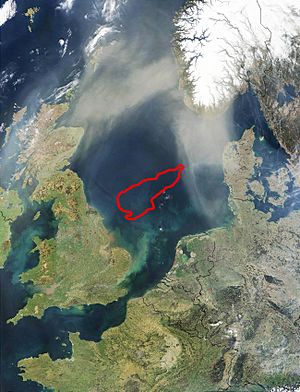Dogger Bank facts for kids
The Dogger Bank is a very large sandbank located in a shallow part of the North Sea. It is about 100 kilometers (60 miles) off the east coast of England.
Long ago, during the last Ice Age, the Dogger Bank was actually part of a huge land area called Doggerland. This land connected what is now mainland Europe with the British Isles. Fishermen have known for a long time that Dogger Bank is a great place to catch fish. Its name comes from the "doggers," which were old Dutch fishing boats used to catch cod.
Today, Dogger Bank is also becoming important for producing clean energy. It has been chosen as a major site for building wind farms.
Contents
What is Dogger Bank?
The Dogger Bank is a huge underwater sandbank. It covers about 17,600 square kilometers (6,800 square miles). That's roughly the size of a small country! It is about 160 kilometers (100 miles) long and 60 kilometers (37 miles) wide. The water above the bank is much shallower than the surrounding sea, usually between 15 and 36 meters (50 to 118 feet) deep.
How Dogger Bank Formed
Scientists believe the Dogger Bank is a moraine. This means it was formed by glaciers during the Pleistocene Ice Age. As the glaciers moved, they pushed and left behind a lot of rock and soil.
During different times of the last Ice Age, the Dogger Bank was either connected to the mainland or was an island. It was part of the larger landmass called Doggerland. This land bridge connected Britain to Europe until it was covered by the sea after the Ice Age ended.
Fishermen who use fishing trawlers in the area sometimes pull up interesting things from the seabed. They have found pieces of ancient peat (decayed plant material), bones from mammoths and rhinoceroses, and even old hunting tools made by people from the Palaeolithic Age (Stone Age).
Earthquake at Dogger Bank
In 1931, a strong earthquake happened right under the Dogger Bank. It measured 6.1 on the Richter scale. This was the biggest earthquake ever recorded in the United Kingdom. The earthquake was felt in many countries around the North Sea and caused damage in eastern England.
History and Battles
The Dogger Bank has been the site of several important events throughout history.
Because of its location in the North Sea, the Dogger Bank has seen a few naval battles:
- In 1696, during the Nine Years' War, a French fleet won a battle against Dutch ships.
- In 1781, during the Fourth Anglo-Dutch War, the British Royal Navy fought a Dutch squadron.
- In 1904, during the Russo-Japanese War, Russian warships mistakenly fired on British fishing boats. This event is known as the Dogger Bank incident.
- During the First World War, two battles took place here in 1915 and 1916 between the British Royal Navy and the German High Seas Fleet.
Shipwrecks
Several shipwrecks lie on the Dogger Bank. For example, in 1966, a German submarine called U-Hai sank during a storm. Sadly, 19 out of 20 crew members died. This was one of the worst peacetime naval disasters for Germany.
Wildlife and Protection
The Dogger Bank is a very important area for fishing. Large numbers of cod and herring are caught here.
The area is also known for having a lot of phytoplankton. These are tiny plant-like organisms that form the base of the ocean food chain. Because of its rich marine life, there have been plans to make Dogger Bank a Marine Nature Reserve. Parts of the protected area are shared by several countries, including the UK, under European Union laws.
Protecting the Seabed
In 2020, an environmental group called Greenpeace dropped large granite boulders onto parts of the Dogger Bank. They did this because they were worried about "supertrawlers" (very large fishing boats) using bottom trawling. Bottom trawling involves dragging heavy nets along the seabed, which can damage the ocean floor and its habitats.
The granite rocks are harmless to marine life and to regular fishing that doesn't drag nets on the bottom. However, they can get tangled in the nets of bottom trawlers, stopping this harmful practice. Greenpeace said that allowing bottom trawling in a protected area is like letting bulldozers drive through a protected forest.
Wind Farms and Future Energy
The Dogger Bank is a great spot for offshore wind farms. It is far enough from the coast that the tall wind turbines won't spoil the view for people on land. Also, the water is shallow enough for traditional wind turbine designs that are fixed to the seabed. These fixed turbines are usually built in water up to 40 or 50 meters (130 to 165 feet) deep. In deeper waters, new floating wind turbines are needed, which cost more to build.
In 2010, a company called Forewind Ltd was given permission to develop a wind farm on Dogger Bank. The plan was to generate a huge amount of power, up to 9 gigawatts. This plan was later changed to a 7.2-gigawatt installation.
Construction of the wind farm has been planned for several years and is now underway.
North Sea Wind Power Hub
Electrical grid companies from the Netherlands, Germany, and Denmark are working together on a big project. They plan to build a "North Sea Wind Power Hub" complex. This could involve creating one or more artificial islands on the Dogger Bank. These islands would be part of a larger European system to produce sustainable electricity. This exciting project aims to bring more clean energy to homes across Europe.
Images for kids
See also
 In Spanish: Banco Dogger para niños
In Spanish: Banco Dogger para niños



